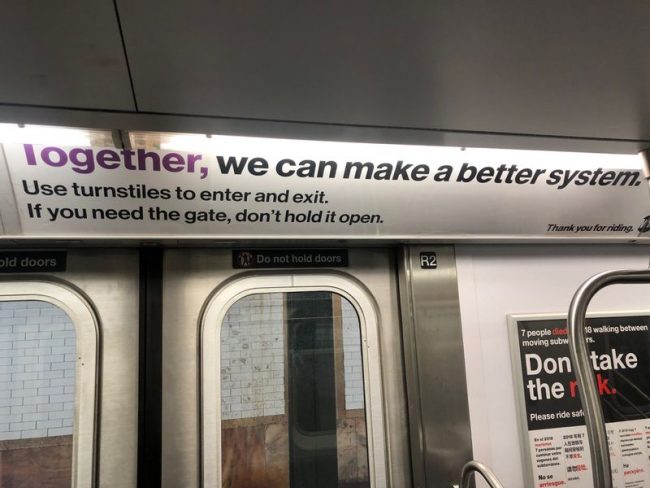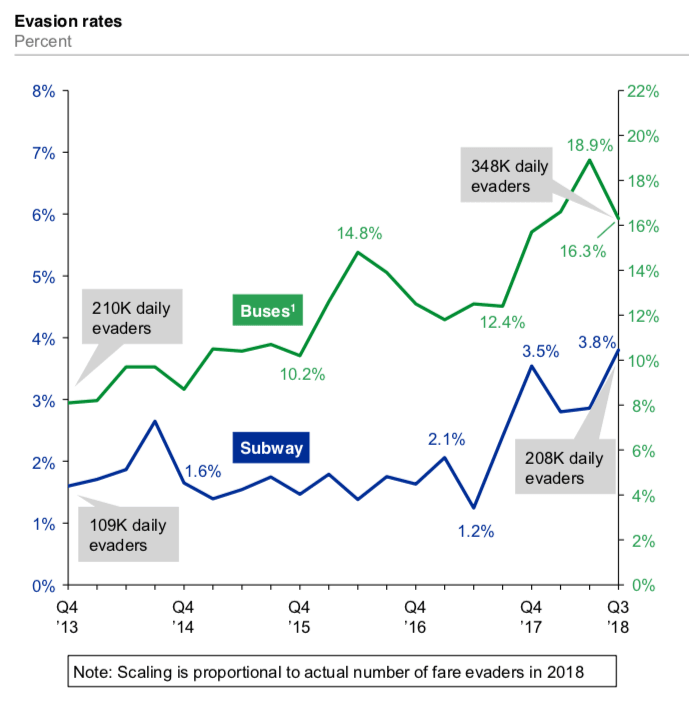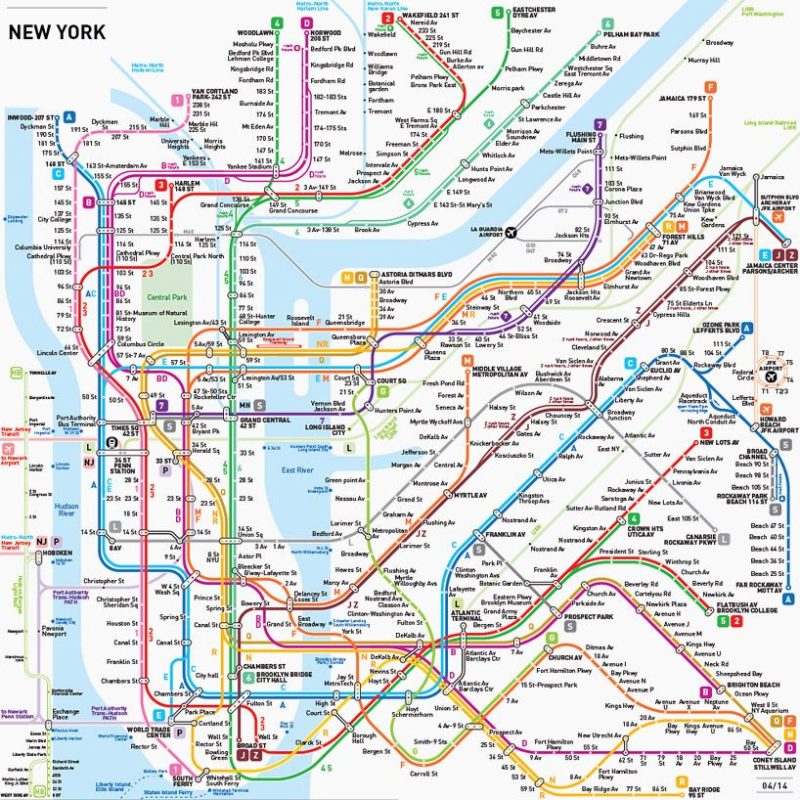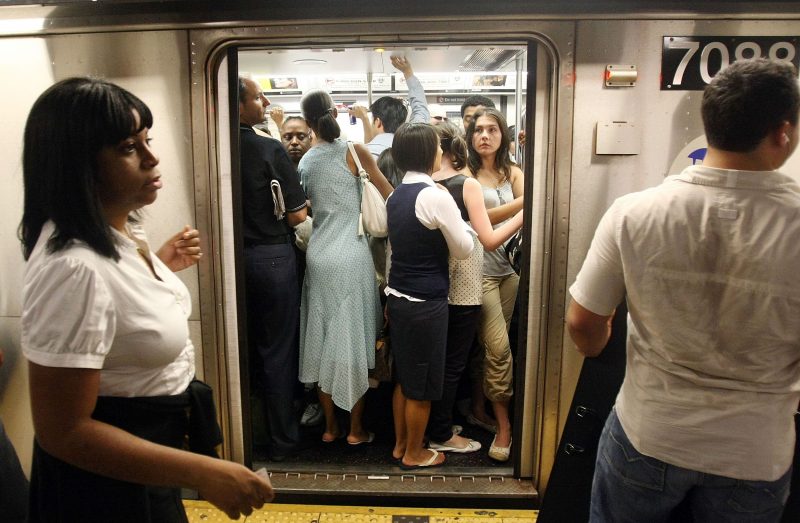Intervening in the Intervention of Fare Evasion
Posted on October 18, 2019- Two uniformed men stand side by side, watching, waiting, sometimes chatting. Their presence is often exceedingly made known, other times they expressly remain covert. To some they look innocuous, others insidious. And in the split second someone who doesn’t notice them jumps the turnstile, everything changes. -
The Crackdown
 [1]
[1]
According to the MTA fare evasion continues to rise on bus and subway routes, resulting in the loss of up to $260 million in revenue per year. In a move New York Governor Cuomo claims will address both fare evasion and assaults on transit workers, 500 police staff (of varying departments) have been deployed in stations where fare evasion rates are high.
In addition to officers’ presence increased video surveillance, visual campaigns and the issuance of summonses will be implemented; methods being funded over four years by $40 million in criminal forfeiture funds. [2]
Following Manhattan and Boston District Attorneys’ decisions to no longer prosecute fare evasion arrests in 2018, MTA and government officials are positioning deterrence rather than criminalisation as the core of this new strategy.
Meanwhile, infrastructure changes such as the introduction of contactless payment options, as well as the newly rolled out Fair Fares programme, are being heralded as further solutions to reduce fair evasion.
The Numbers Don’t Add Up
 [3]
[3]
This intervention in fare evasion has been met with congratulation but also criticism and contention.
One point of such contention is the resourcing and resulting costs this strategy will engender. Quick ‘back of the envelope’ calculations show that the additional deployments alone will cost $66,575 a day, some 24,000 people’s fares.
Officials are claiming that the additional officers (representing a 20% increase of those currently deployed in the transit system) will not encumber any additional costs. And in quick comparison the $40 million being spent over four years is a fraction of the purported $260 million being lost due to fare evasion per year. It is being pointed out however that these figures don’t account for the ‘administrative’ costs this new intervention will elicit both in the transit and wider systems. In addition there are strong beliefs that the $40 million is not being spent on the right intervention.
Another point of contention is data on fare evasion the MTA authorities are using to prop up their case for interventions. The Office of the Inspector General has stated concerns regarding the legitimacy of the figures due to inaccurate and flawed data collection methods [4]. Further to this, the MTA have been criticised by journalists and activists for the lack of data included in their eight page power point presentation [5] at the end of last year.
Alongside this, the NYPD have missed several deadlines to produce and provide full quarterly reports on fare evasion interventions, something that is required by them under a law passed in 2017. The NYPD defended its stalling citing that the information could risk public safety by attracting criminals to locations of low police presence – a stance that Judge Arthur Engoron called “speculative at best, and improbable at worst” [6]. In a ruling made at the end of last month state Supreme Court Judge ordered the NYPD to release the data under the Freedom of Information Law request. The data is yet to be released.
These points of concern, while valid, skate on the surface of a much deeper issue of fare evasion ‘solutions’.
Criminalising Poverty and Communities of Colour
 [7]
[7]
Fare evasion intervention tactics have long garnered scathing criticism for their criminalisation of poverty and the targeting and punishment of low-income citizens and communities of colour.
In a 2017 report the Community Service Society (CSS) states that “for decades, [the] country’s criminal justice system has institutionalized policies that have criminalized poor communities of color” with “broken windows policing…[targeting] low-income neighborhoods for non-violent crimes of poverty” [8].
Data released by the NYPD earlier this year corroborates this, highlighting sharp racial disparities in fare evasion enforcement. From January to June of this year, 89 percent of those arrested and 79% of those issued summonses for fare evasion were either Asian, Black or Hispanic.
Targeting and arresting low-income New Yorkers of colour has historically resulted in heavy loads on the justice system. In previous years New York City has spent up to $50 million dollars (without factoring in costs of detainment of individuals) to arrest, prosecute or fine low-income New Yorkers. Much more importantly, burdens have fallen on low-income communities of colour who face potential lifelong consequences such as a criminal record, jail time and trauma for being unable to afford to pay $2.75.
In this new intervention that privileges deterrence and summonses the number of arrests should be seen to drop. It would however be naive to believe that this alleviates the burden on low-income communities of colour. Not least do summonses still come with a price attached (that of $100 which those evading paying $2.75 will be unlikely to afford) but police officers retain the ability to exercise their discretion in who they stop and issue summonses to. As the CSS states, “this discretion opens the door to both explicit and implicit biases that correlate with race, ethnicity, age, and gender” [8].
Fare evasion intervention has a history of enacting both symbolic and literal violence on low-income communities of colour. This new method of intervention, regardless of intention, will likely continue to do the same in a multiplicity of harmful ways.
The Systems of Systems
 [9]
[9]
The transit system is exactly that, a system. This latest effort to intervene in the system is another ‘solution’ that fails to understand not only the complexity of the transit system but the wider systems (and the reinforcing and balancing feedback loops, stocks and flows) that impact it.
Systems thinker Donella Meadows points out, that it is “dangerous to generalise about complex systems” [10]. It follows then that it is dangerous to design interventions based on generalisations or on the desire for a linear ‘silver bullet’ answer. As Rittel and Webber state in their seminal paper Dilemmas in a General Theory of Planning, “every implemented solution is consequential” and “leaves traces that cannot be undone” [11]. The ineffectiveness and harm caused by fare evasion interventions stand as clear examples of such traces that cannot be undone.
Turning a blind eye to history and contemporary actions it could, at a push, be argued that it is not the intention of the NYPD, MTA or any official’s to cause harm to low-income communities of colour. But as designers Boehnert and Onafuwa argue “emotional carelessness brought about by inadequate understanding of the perspective of others” [12] is also violence and is just as reprehensible.
The How, What and Who
 [13]
[13]
There are plenty of alternate suggestions for ‘solving’ fare evasion on the New York transit system. They range from making transport free for all, to adding technology infrastructure to fine people immediately. It is tempting to offer suggestions as such, but doing so would continue to miss the mark.
Perhaps what is much more worthwhile, much more interesting, much more challenging, is thinking not about the how, or the what, but the with whom.
Something that is too often overlooked, whether by accident or choice, is working with those who are in the systems we are trying to understand, affected by the problems we are trying to solve, perpetrating the problems we are trying to solve. Those who, as feminist scholar Donna Haraway puts it, have “situated knowledge”[14].
Working with (and appropriately compensating) those with situated knowledge, is not only a means of understanding the problem and the system, but also an opportunity to, in turn, design better solutions.
This ‘working with’, or “becoming with” [15], to use another one of Haraway’s terms, is simple but not easy. ‘Working with’ is in direct opposition to many held beliefs or ways of doing in the 21st century and for that reason exactly is also an imperative. Not because systems can’t be changed without ‘working with’, they surely can. But because effective, innovative and equitable systems can not be designed without. And we are in dire need of such systems.
So if the goal of the MTA is truly to “enhance the quality of life and economic health of the region it serves through the cost-efficient provision of safe, on-time, reliable, and clean transportation services” [16] it will reconsider outdated fare evasion interventions and invest in ‘working with’ to build a better transit system for all.
And if they don’t, there are plenty of us who, in the words of Meadows, will continue to articulate, mean, repeat, stand up for, insist upon and demand a more effective, just, and equitable transit system.
-Rose